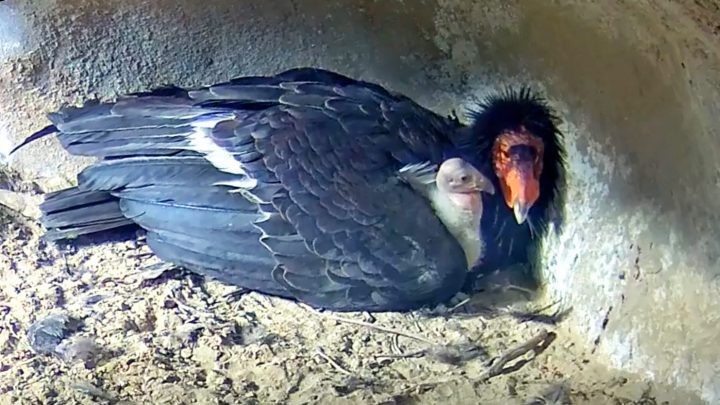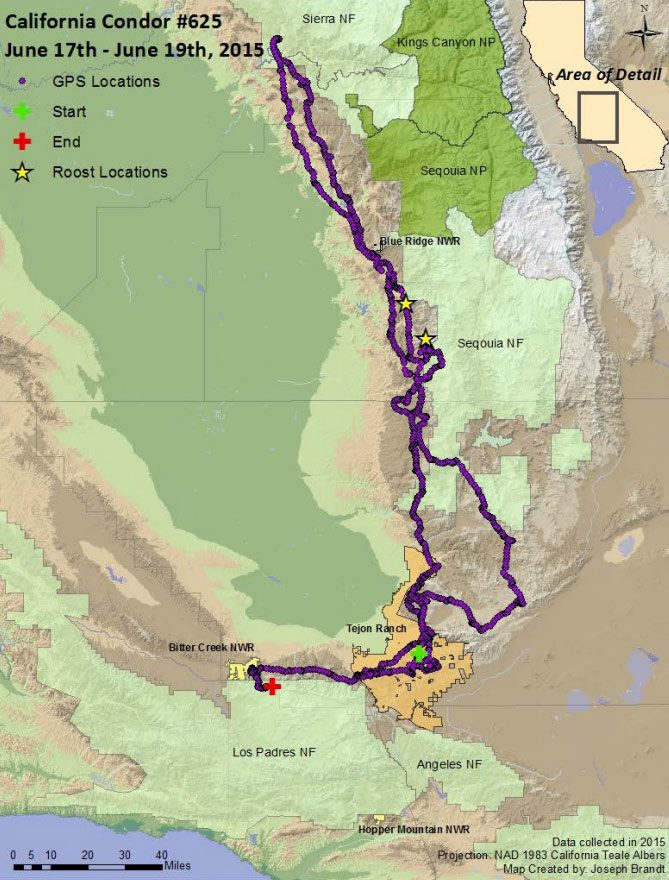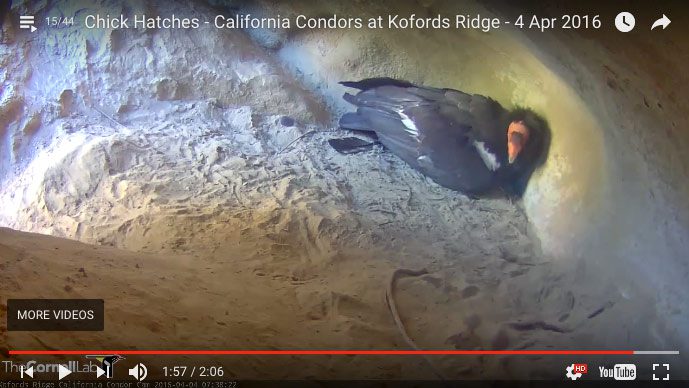Raising a California Condor Chick Takes Hard Work—by Birds and Humans Alike
By Ben Walters
May 30, 2017
California Condors work hard to raise their chicks. Every year or two, an adult female lays a single egg that weighs 9–10 ounces. She and her mate incubate the egg for 2 months, and when it hatches they spend another 6 months or so feeding it meals of regurgitated carrion. The youngster remains semi-dependent for up to a year after it takes its first flight, as it learns how to forage, care for itself, and interact with other condors. In this laborious manner, 35 condor chicks have fledged from wild nests since 2001, as the free-flying population of this critically endangered species slowly climbs into the hundreds.
But it doesn’t just take two adult condors to raise a baby in today’s world—there’s also a team of 35 wildlife biologists and research technicians working long hours in the field to help keep nests, eggs, and chicks safe. They are part of the California Condor Recovery Program, whose work includes captive breeding, increasing nesting success in the wild, and making sure wild condors stay healthy.
Thanks to these measures, California Condors have bounced back from a low of only 27 individuals in 1987, all in captivity, to 435 individuals, with 268 flying free as of 2017 in California, Arizona, Utah, and Baja California. Yet wild populations are still threatened by lead poisoning, trash ingestion, and other hazards. Lead poisoning alone has caused at least 72 condor deaths since 1984 and is a primary reason why wild populations still depend on intervention.
Despite these numbers, condors took a major step toward recovery when they began reproducing in the wild again in 2001 after nearly 30 years of captive breeding. Despite success in monitoring and treating lead-poisoned condors, the recovery team found nests were still failing at an unnaturally high rate. In Southern California, only 1 chick fledged out of 16 nests between 2001 and 2006.
It was clear that something besides lead was causing nests to fail, and it was up to the recovery team to find out what that was. They soon found that fully half the chicks had died from eating small indigestible objects: “Bits of glass, bits of metal, bits of plastic, washers, bullet casings—all the stuff that we now [refer to] as microtrash,” says Joseph Brandt, a supervisory wildlife biologist for the recovery program. Condors can tolerate small amounts of these materials, but lethal amounts were building up in the digestive tracts of these nestlings, causing impactions that led to poor digestion, underdevelopment, and eventually death.
Nest Safety Taken Seriously
So the recovery team began a program they called “nest guarding,” which involves monitoring condor pairs as they begin to court and nest, then intensively managing nests, eggs, and chicks all the way through the nesting period. Techniques include repeated “nest entries” in which a biologist rappels into nests up to four times per nesting attempt to check egg fertility, search for microtrash, and give chicks a checkup. Thanks to these efforts, nesting success has increased nearly tenfold, with 33 of 59 Southern California nests fledging young between 2007 and 2016.
Once a new nest is under way, the recovery team schedules three nest entries. The first takes place during incubation. A biologist holds the egg in front of a flashlight to check if it’s fertile (about a quarter of condor eggs are naturally infertile). If it’s infertile, the team will schedule another visit to replace it with a fertile egg from the captive breeding program, giving the pair a second chance. If possible, they also set up a remote nest camera to monitor the nest and respond to emergencies, like when an egg disappeared overnight on the 2016 condor cam.
After the chick hatches, the team enters the nest again when the chick reaches 2 months and 4 months of age. In addition to rappelling down the cliff, researchers must now corral a wild condor chick (weighing up to 20 pounds) with nothing but their hands. On these visits, researchers attach a numbered tag and radio transmitter to the chick’s wing, take blood samples to test for lead poisoning, vaccinate the bird for West Nile Virus, and sift the entire nest cavity for microtrash.
Any chick suffering from a microtrash impaction must be treated quickly. The team calls in a helicopter to transport the chick to the Los Angeles Zoo for emergency surgery. Meanwhile, there’s the possibility the adults will return to an empty nest. To keep them from abandoning the nest, a “lucky” team member camps out in the nest cavity for up to 24 hours to keep the adults at bay until the chick returns. “It’s not necessarily a pleasant place to spend the night,” says Brandt.
Out of the Nest, and Harder to Keep Safe

Once a chick fledges, it moves beyond the physical reach of the recovery team and into a world filled with many new dangers. Young condors must stay clear of falling rocks, navigate steep cliffs as they hone their flying skills, and avoid predators like Golden Eagles, bobcats, and coyotes.
The chicks’ newfound mobility makes it hard for the recovery team to do more than track the birds by their transmitters. Older condors can be trapped at carcasses, but the lumbering fledglings don’t follow their parents to feeding grounds until the late stages of dependency. This juvenile stage is one of the most vulnerable times for a condor. It’s not until 2 years of age that its chances of survival will improve. During this period, the team can only watch and hope that the chick avoids the pitfalls that await it until adulthood.
As the intensity of the breeding season winds down, the recovery team changes focus to assessing the health of the entire wild population. Biologists track the condors over their 15,000-square-mile home ranges using satellite and radio transmitters embedded in the birds’ wing tags. Each year, every member of the flock is recaptured, checked for lead poisoning, and given a fresh transmitter. The resulting data helps the team understand condor movement, food sources, pairing, social interactions, and even causes of death.
“If you boil endangered species recovery down to its simplest form,” says Brandt, “you need to have habitat, you need to have the animal you’re managing to not die prematurely, and you need to have it reproducing…we’re addressing all three of these issues with condors.” With luck—and an eventual solution to the problem of lead poisoning—these efforts will someday bear a sustainable population of wild-breeding California Condors.

All About Birds
is a free resource
Available for everyone,
funded by donors like you
American Kestrel by Blair Dudeck / Macaulay Library

